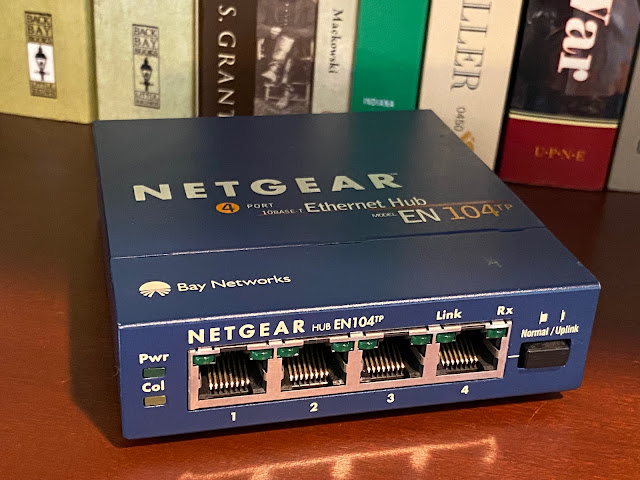Over the weekend I organized some old computing equipment. I found this beauty in one of my boxes. It's a Netgear EN104TP hub. I've mentioned this device before, in this blog and my books. This sort of device was the last of the true hubs. In an age where cables seem reserved for data centers or industrial facilities, and wireless rules the home and office, this hub is a relic of days gone past.
To give you a sense of how old this device is, the Netgear documentation (still online -- well done) offers a PDF created in August 1998. (Again, well done Netgear, not mucking about with the timestamps.) I'm not sure how old my specific device is. Seeing as I started working in the AFCERT in the fall of 1998, I could see this hub being easily over 20 years old.
A hub is a network device that accepts traffic from its ports and repeats the traffic to all other ports. This is different from a switch, which maintains a table identifying which MAC addresses are in use on which ports. Before building this CAM (content addressable memory, IIRC) table, traffic to a new previously unforeseen MAC address will appear on all ports save the sender.
This is a "true hub" because all of the ports are 10 Mbps. Yes, that is 100 times "slower" than the Gigabit ports on modern devices, if they have Ethernet ports at all. Starting with 10/100 Mbps devices, they all became switches. I never encountered a 100 Mbps "hub." Every device I ever had hands on was a 10/100 Mbps switch. That meant you were unlikely to see traffic on all ports when using a 10/100 Mbps device or even a 100 Mbps device (which I never saw anyway). There were no Gigabit (1000 Mbps) hubs built. I don't think the specification even supports it.
These little boxes were network monitoring enablers. If you wanted to learn, or troubleshoot, or possibly even add monitoring to a production network, you could connect an upstream cable, a downstream cable, and a monitoring cable to the hub. The upstream could be a router and the downstream might be a firewall, and the monitoring would be your NSM server. If you were looking at traffic between two individual computers and needed visibility for a NSM laptop, you would plug all three into the hub, and plug your Internet upstream into the fourth port.
I haven't needed this device in years, but I plan to keep it as a physical artifact of a time long past. At least this one still powers on, unlike my first computer, a Timex Sinclair ZX-80.
如有侵权请联系:admin#unsafe.sh
